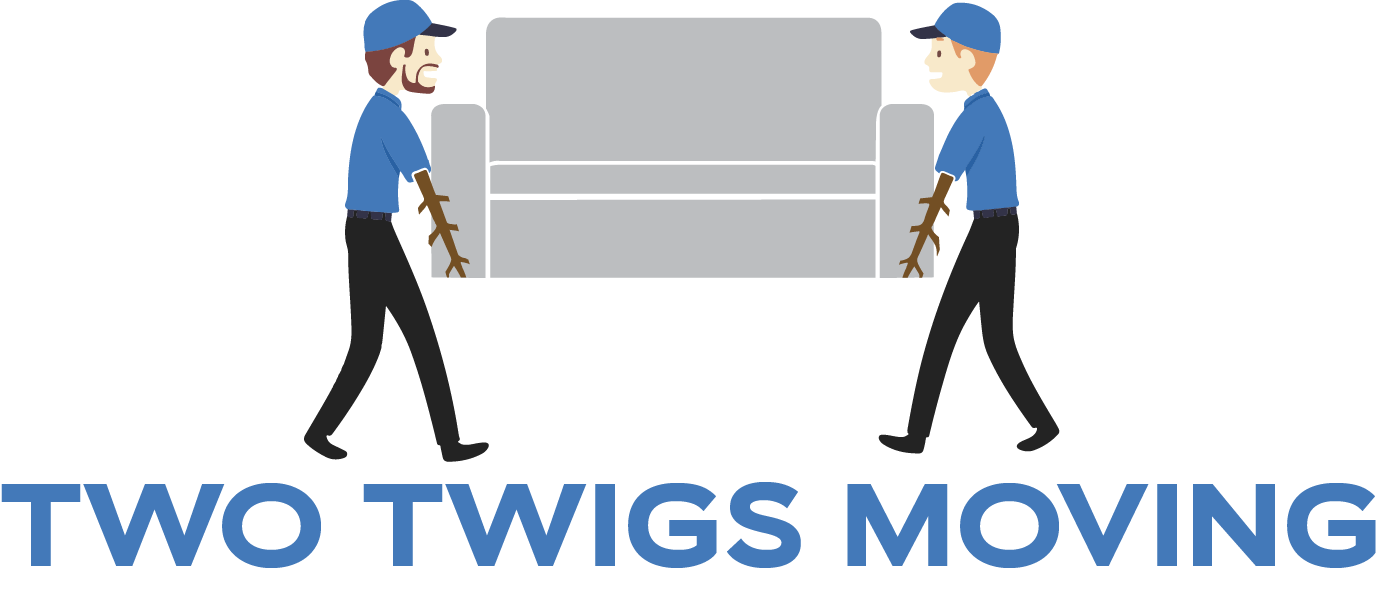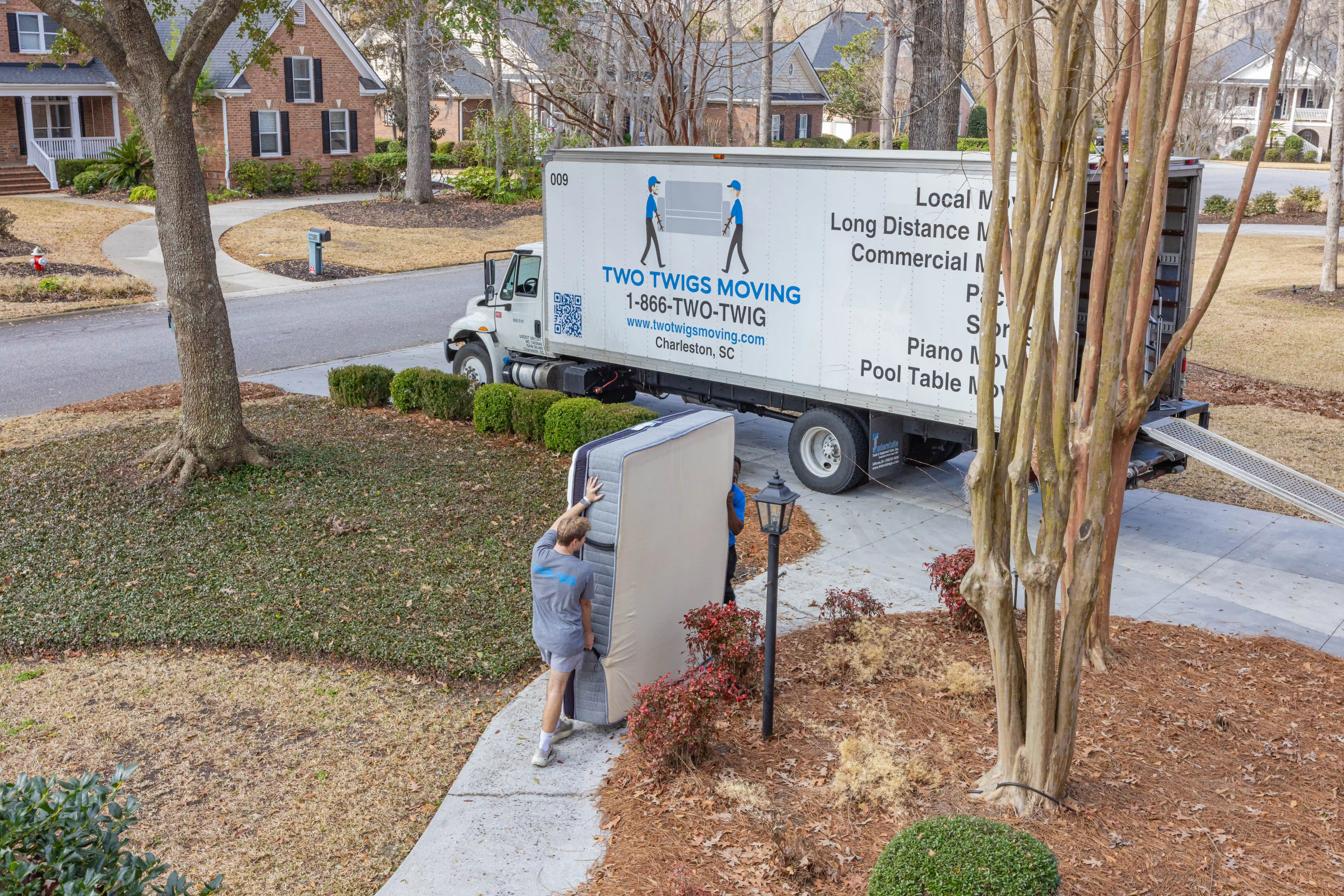Moving long-distance from Charleston can be expensive, but understanding the main costs and planning effectively can help you stay on budget. Here’s what you need to know:
- Transportation Costs: These are based on the weight of your items and the distance. Expect higher costs for oversized items or peak-season moves (May–September).
- Packing and Materials: Professional packing services and materials can add hundreds of dollars. Packing yourself or opting for partial services can save money.
- Specialty Items: Moving delicate or large items like pianos or artwork often requires extra fees for specialized handling and equipment.
To save money, consider packing yourself, moving during off-peak months (October–April), and decluttering to reduce the weight of your move. Always set aside a contingency fund (10–15% of your budget) for unexpected expenses. Professional movers like Two Twigs Moving offer flexible service options to meet your needs, from basic loading to full-service moves. Get detailed quotes and plan ahead to ensure a smooth and cost-effective relocation.
Main Long-Distance Moving Costs
Knowing the key components of long-distance moving expenses can help you plan financially for your Charleston relocation. These costs generally fall into three primary categories, each with its own pricing factors.
Transportation Costs
Transportation typically makes up the largest chunk of a long-distance move’s cost. Unlike local moves, which are often billed hourly, long-distance moves are priced based on the weight of your belongings and the distance traveled. For example, moving a 2–3 bedroom home within 1,000 miles might set you back a few thousand dollars, while moving over 2,500 miles costs significantly more.
Fuel surcharges are another factor, often added as a percentage of the base transportation fee, and they fluctuate based on market gas prices. The size of the truck and any special equipment required will also impact the cost. Standard moves usually rely on 26-foot or 53-foot trucks, but if you have oversized items, specialized trailers might be necessary, further increasing your expenses. Additionally, moving during peak season (May through September) often comes with higher rates due to increased demand.
On top of transportation, packing services and materials can add to your overall bill.
Packing and Materials
Packing-related expenses are another key factor in your moving budget. Professional packing services and high-quality materials ensure your belongings are protected during transit, but they can add several hundred dollars to the total cost. Full-service packing is typically billed hourly, with rates depending on the number of packers needed.
For those looking to save, some companies offer partial packing services. These focus on safeguarding delicate or valuable items, such as artwork or fragile electronics, while leaving you to pack less sensitive items yourself. This approach can help reduce costs without compromising the safety of your prized possessions.
Specialty Item Handling
Handling specialty items often comes with additional fees. Items that are delicate, valuable, or oversized may require specialized equipment and expertise, which can drive up costs depending on the complexity of the job.
Take piano moving, for example. Upright pianos are generally less expensive to move than grand pianos, which may require disassembly and specialized handling equipment. Similarly, artwork and antiques often need custom crating or even climate-controlled transport. Professional crating services add to the expense, and high-value items may require the expertise of art handlers.
Large items like pool tables or hot tubs also come with extra costs for disassembly, careful handling, and precise reassembly. Additionally, challenging access situations – such as navigating stairs, narrow doorways, or long distances from the truck to your home – can increase labor and equipment costs. In extreme cases, services like crane rentals or obstacle removal may be required, adding even more to your final bill.
How to Create Your Moving Budget
Once you’ve identified the factors that influence your moving costs, the next step is to create a practical budget. Start by gathering detailed quotes and breaking down expenses to spot areas where you can cut costs. Let’s dive into some tools and strategies to help refine your moving budget.
Using Moving Cost Calculators
Online moving cost calculators can give you a quick estimate based on details like your zip codes, home size, and moving date. These tools consider factors like distance, weight, and seasonal price changes.
To get the most accurate estimate, be precise when listing your inventory. For example, a three-bedroom home typically weighs between 9,000 and 12,000 pounds. Accounting for all your belongings thoroughly can help you avoid surprise fees on moving day.
Keep in mind, though, that these calculators provide estimates, not binding quotes. Use them as a starting point, and then request in-home estimates from professional movers for more precise numbers.
Choosing Must-Have Services
It’s important to separate essential services from optional ones. Transportation and basic loading/unloading are non-negotiable, but additional services should align with your specific needs.
For instance, if you’re moving fragile items like artwork, antiques, or electronics, full-service packing might be necessary. On the other hand, packing everyday items – like clothes and books – yourself can save you money. Consider opting for partial packing services that focus only on delicate or high-value items.
Storage services may also be a factor if your new home isn’t ready when you are. Short-term storage typically costs between $50 and $300 per month, so be sure to include this in your budget if there’s any uncertainty about your move-in timeline.
If time or physical limitations are a concern, investing in extra services can ease the process.
Setting a Contingency Fund
Always set aside a contingency fund – around 10% to 15% of your moving budget – to handle unexpected expenses. For simpler moves, a 5% to 10% buffer might be enough. However, if your move involves specialty items, tight deadlines, or difficult access, consider reserving 15% to 20% for surprises.
Unplanned costs might include extra packing materials, labor charges for challenging access, or higher storage fees if your move-in date is delayed. Weather-related delays, especially during winter, can also add to your expenses.
Doug Vincent, Co-founder and CEO of Mastt.com, offers a helpful analogy:
"It’s like packing an umbrella on a sunny day – you hope you won’t need it, but you’ll be glad to have it if the weather changes."
- Doug Vincent, Co-founder and CEO, Mastt.com
If you don’t end up using your contingency fund, that’s a win. You can put the leftover money toward settling into your new home or save it for future needs. Either way, having that cushion ensures you won’t run into budget issues.
Ways to Save Money on Long-Distance Moves
Long-distance moves can be expensive, but there are smart strategies to help you cut costs while still ensuring a smooth transition.
Packing Items Yourself
One of the easiest ways to save money is by packing your belongings yourself. By skipping professional packing services, you can avoid those extra fees. Start by gathering free packing supplies – check with local stores or ask around for sturdy boxes. You can also get creative by using things you already own, like towels, blankets, and clothing, to cushion fragile items. Suitcases and duffel bags can double as packing containers, saving you even more. Timing your move strategically can also have a big impact on your budget.
Moving During Off-Peak Times
Choosing the right time to move can make a big difference in your expenses. Did you know that nearly half of all moves happen during the summer? On the flip side, winter sees only about 10% of moves. The off-peak season – typically October through April – is when moving rates are generally lower. The most budget-friendly months are January, February, March, September, and November, with January and February often offering the best deals. For those in Charleston, fall is an especially good time to move, thanks to cooler weather, reduced humidity, and lighter traffic. Additionally, scheduling your move for mid-week and mid-month can help you avoid peak demand and save even more.
Decluttering Before the Move
The fewer items you move, the less you’ll pay – especially since long-distance moves are usually priced by weight and volume. Decluttering is key. Start early, tackling one room at a time, and sort your belongings into four categories: keep, sell, donate, or discard. Reducing the amount of stuff you need to pack will lower your transportation costs and make the whole process more manageable. Selling items you no longer need can even help offset some of your moving expenses, while donations may qualify for tax deductions and benefit your community. Don’t forget to properly dispose of hazardous materials like paint, propane tanks, and chemicals – most movers won’t transport these items, and local disposal programs can help. Plus, decluttering offers a fresh start, letting you settle into your new home with only the essentials.
sbb-itb-a5538b6
Why Choose Professional Moving Services
While DIY moving might seem like a cost-saving option, professional movers like Two Twigs Moving provide essential advantages, especially for long-distance relocations from Charleston.
Customizable Service Packages
Two Twigs Moving offers a range of flexible service packages, allowing you to balance convenience and cost. Their Basic Moving package includes the essentials – loading, transportation, and unloading – perfect for those who prefer to handle packing on their own. For a more hands-off experience, their Full-Service Move takes care of everything from packing to unpacking.
You can mix and match services to suit your specific needs. For instance, you might pack everyday items yourself but rely on professionals for fragile or bulky belongings. This flexibility ensures you only pay for the services you truly need.
If you’re renting your own truck but need help with heavy lifting, their Labor Only option is a great choice. And if your new home isn’t move-in ready, their Storage Solutions can bridge the gap, keeping your belongings safe until you’re ready.
Beyond these packages, professional movers bring expertise in handling delicate and oversized items, offering peace of mind during the entire process.
Expert Handling of Specialty Items
Some belongings require more than just care – they need professional expertise. This is where specialized moving services truly shine. Two Twigs Moving offers Specialty Moving services designed to handle unique or delicate items with precision.
"Professional movers bring specialized skills that reduce the risks associated with moving specialty items, ensuring they arrive in pristine condition", says Capitol Moving & Storage.
Using advanced tools like dollies, lifting straps, protective padding, and custom rigging equipment, professional movers ensure even the heaviest or most awkwardly shaped items are transported safely. For particularly fragile items, custom crating with shock-absorbing materials adds an extra layer of protection.
Climate-sensitive belongings, such as fine wooden furniture, artwork, or musical instruments, benefit from temperature-controlled transport. These services maintain a steady environment between 55–85°F, preventing damage like warping or cracking. While this option can increase costs by 25–35%, it’s a worthwhile investment to protect valuable items.
In addition to safeguarding your belongings, professional movers help avoid unexpected expenses or delays, making the process smoother and more predictable.
Peace of Mind and Efficiency
Hiring professional movers isn’t just about convenience – it’s about expertise that saves time and prevents headaches. Two Twigs Moving’s trained team uses proper techniques and efficient loading strategies to ensure smooth transport.
Their services include Full Value Protection (FVP), which guarantees the replacement of lost or damaged items. This added financial security goes beyond what a DIY move can offer.
Professional movers can often complete a move in a single day, handling everything from disassembling furniture to optimizing truck space and navigating logistics. Their adherence to industry safety standards also reduces the risk of accidents or property damage.
When you consider potential costs from injuries, damaged belongings, or the stress of a DIY move, professional services often prove to be a smarter, more economical choice. With their tailored approach and efficient execution, professional movers like Two Twigs Moving ensure a smooth, stress-free relocation experience.
Conclusion: Planning Your Long-Distance Move from Charleston
Planning a long-distance move from Charleston becomes much easier when you understand the costs involved and set a clear budget. Breaking down your expenses helps you create a realistic financial plan that works for you.
Balancing cost and convenience is key. While self-packing and scheduling your move during off-peak times can save you money, professional services often provide more value in the long run. Two Twigs Moving offers flexible packages to suit your needs, ranging from full-service options to labor-only assistance. They also specialize in handling delicate items, ensuring your valuables are treated with care.
To get started, reach out to Two Twigs Moving for a free, customized quote. Charleston residents can provide details about their current home, destination, and any special requirements – like moving a piano or a pool table – to receive an accurate estimate. Transparent pricing eliminates surprises, so you can confidently budget for your move.
If upfront costs are a concern, there are flexible payment options available through Wisetack. This makes it easier to access professional moving services while ensuring your belongings are handled by experts.
With a well-thought-out budget and a tailored service plan, your move can be smooth and stress-free, with your belongings arriving safely at your new home.
FAQs
How can I estimate the weight of my belongings for a long-distance move?
To estimate the weight of your belongings for a long-distance move, start by listing everything you plan to take, going room by room. As a rule of thumb, household goods typically weigh around 7 pounds per cubic foot, and for larger homes, you can estimate about 1,500 pounds per room. If you want a more exact figure, online moving weight calculators can be a helpful tool, or you could weigh the moving truck before and after loading your items.
Don’t forget to account for specialty items like pianos or oversized furniture, as these can significantly add to the total weight. Taking these steps will give you a clearer picture of your moving load, helping you plan and budget with confidence.
What’s the best way to compare moving company quotes to ensure I get a fair deal?
When searching for the best deal on moving services, it’s smart to request at least three detailed quotes from different companies. Make sure each quote outlines the same services – such as packing, loading, and transportation – so you can compare them fairly. To avoid surprises, go for binding estimates or flat-rate pricing. For the most accurate pricing, ask movers to provide written quotes after completing an in-home assessment.
It’s equally important to check each company’s credentials and reputation. Look for proper licensing, insurance coverage, and customer reviews to ensure you’re hiring a reliable and trustworthy moving service.
What unexpected costs should I watch out for during a long-distance move, and how can I plan for them?
Unexpected expenses during a long-distance move can sneak up on you. These might include charges for packing materials, disassembling and reassembling furniture, handling delicate or oversized items like pianos, fuel surcharges, or even storage fees if your belongings need to be held temporarily. If you’re not prepared, these costs can pile up fast.
To avoid financial surprises, it’s a good idea to set aside a contingency fund for unexpected costs. Decluttering your belongings before the move can also help reduce the overall weight and size of your shipment, which may lower your expenses. Additionally, ask your moving company for a detailed estimate that highlights any potential extra fees. A little planning can go a long way in keeping your budget intact.


.svg)


